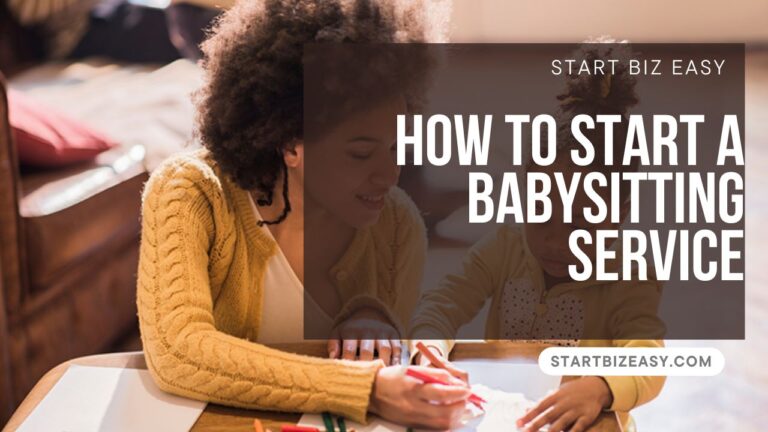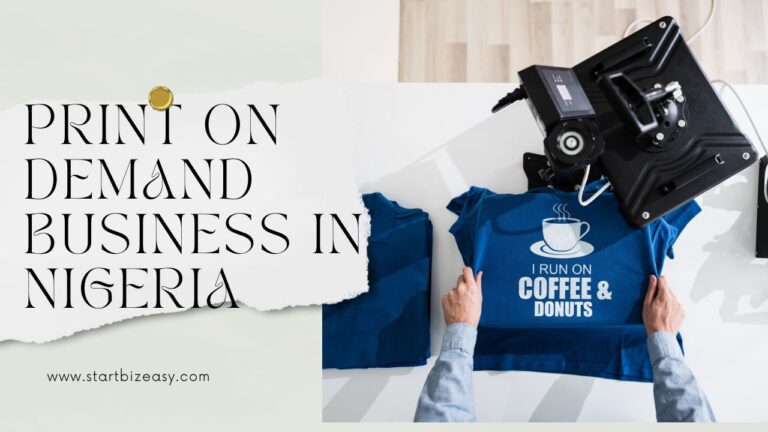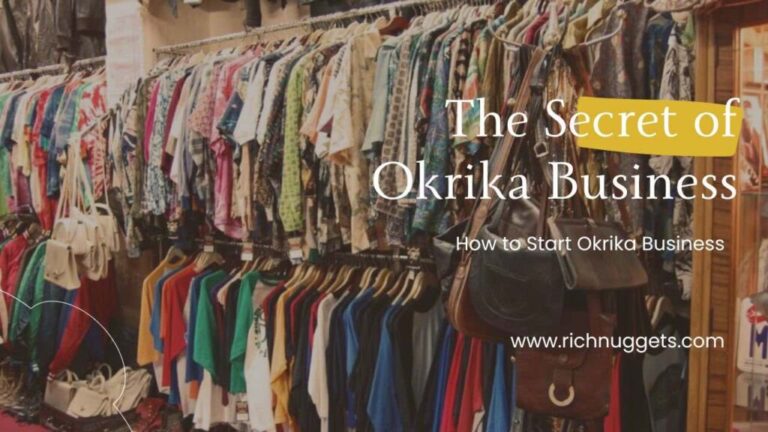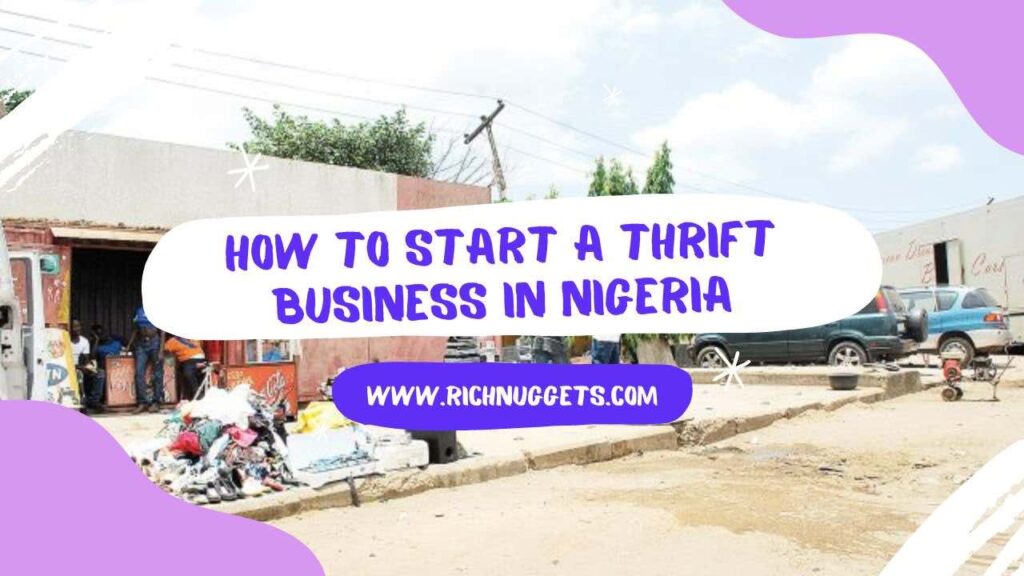
Thrift business means selling used items such as clothes, electronics, furniture, books, etc with the intention to raise money for charity.
But in a country like Nigeria, the intention is not to raise money for charity but to make a living.
Over time, thrift business has been mistaken to be another name for Okrika business, but in reality, it is more than Okrika business in scope.
Okrika business deals solely with the sale of used clothes, whereas the thrift business encompasses a wider range of second-hand items for sale, including laptops, televisions, irons, rugs, and more.
Furthermore, in terms of profitability, the thrift business surpasses the Okrika business. The thrift business benefits from a wide range of customers due to its diverse range of items on display for sale. On the other hand, the Okrika business is limited to a specific target market because it focuses solely on clothing.
The focus of this article is on how to start a thrift business in Nigeria, not how to start Okrika business. With that being said let’s delve right in.
Table of Contents
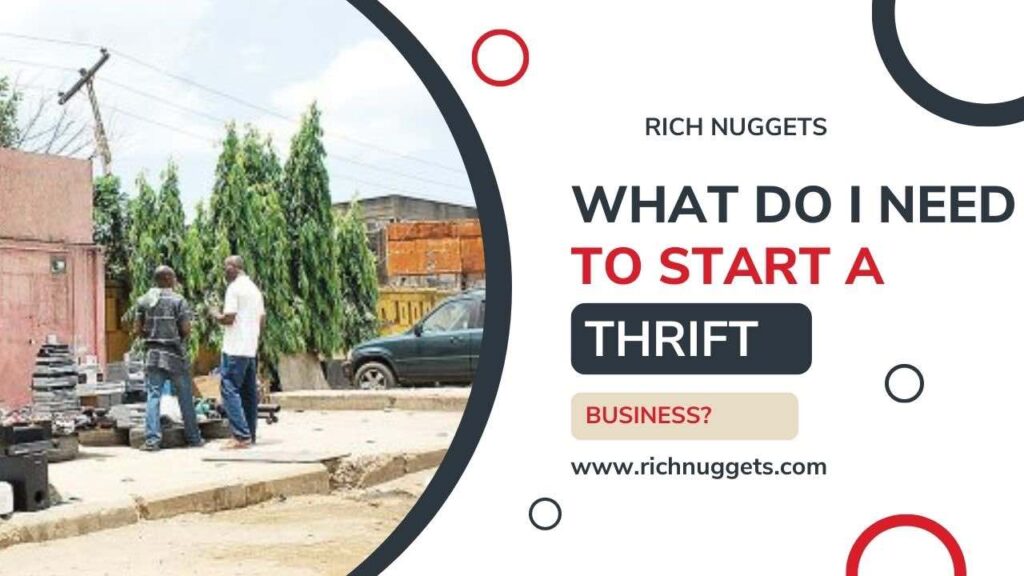
1. Define your Business:
The first step is to define your thrift business in terms of how you are going to operate and source your inventory.
It is essential to establish a clear operational plan for your thrift business, defining whether you intend to operate it occasionally, by capitalizing on seasonal sales such as the December sales, or run it as a day-to-day business.
Opting for a day-to-day business model may mean, you still getting involved with the shipping process which entails having multiple sources for shipping your thrift items to ensure a consistent stock supply. Or it may mean, you running your thrift business as a retailer that buys from those that get involved with the shipping process to sell as a retailer.
No matter your mode of operation, the thrift business is generally a profitable business.
Moreover, it is valuable to identify any unique operational procedures that differentiate your thrift business. This could include aspects like specialized quality control measures, customized pricing strategies, or creative marketing techniques.
By carefully considering these operational aspects and establishing a clearly defined business, you can effectively manage your thrift business, attract customers, and differentiate yourself within the market.
2. Business Plan:
The next step is to have a business plan. The business plan doesn’t need to be like a professional business plan, a maximum of 2 to 3 pages is enough to have that perfect business plan for this business.
The business plan should cover knowledge areas such as;
- Goals: Clearly define the objectives and goals you want to achieve with your thrift business. These may include financial targets, market share, expansion plans, or social impact goals.
- Target Market: If your goal is to sell a wide range of items, then you may want to give room for a large customer base. But if your goal is to sell a particular item, eg Television, then you may want to be strategic when identifying your target market by considering factors such as their demographics, preferences, needs, and purchasing behavior.
- Pricing Strategy: Determine how you will price your thrift items. Consider factors such as acquisition costs, market demand, competition, and profit margins. Your pricing strategy should align with your target market’s affordability and perceived value of the items.
- Marketing Plan: Marketing a thrift business in Nigeria, comes with no cost. All there is to do is to locate that perfect location, display your items, and you will see people trooping in like a marketplace.
- Financial Projections: Estimate the financial aspects of your thrift business, including sales projections, expenses, and profitability. This includes forecasting revenue, cost of goods sold, operating expenses, and expected profits over a specific period. Financial projections help you assess the viability and potential profitability of your business.
- Operational Details: Operational details encompass various aspects, including inventory management, procurement processes, store layout, staffing requirements, customer service standards, and any distinctive operational procedures that set your thrift business apart.
So many people may have many good reasons and tales to tell you about how inconsequential it is to have a business plan. they often fail to disclose the challenges they encountered by starting without one. It is advised that starting a thrift business should begin with a business plan and it doesn’t need to be a professional business plan.
3. Legal Registration:
This may be optional to those running an occasional thrift business but compulsory to those running a day-to-day thrift business. Registering your business will save you a lot from those greedy tax collectors who prey on unregistered businesses because they know that if you refuse to comply with their demands, they can report your business for being unregistered, which will eventually cost you more money.
To safeguard against such issues, it is advisable to register your thrift business with the Corporate Affairs Commission (CAC). The registration process itself is affordable, costing no more than 10,000 Naira if you choose to handle the business name registration personally. However, if you prefer to utilize an accredited agent, the total cost, including both the registration and their professional fee, amounts to N25,000 Naira.
4. Location:
The location of your thrift business plays a crucial role in its success. Choosing the right location for your thrift business requires careful analysis of some factors such as;
- Foot Traffic: Look for areas with high foot traffic, such as busy streets, shopping centers, or commercial districts. A location with a steady flow of people increases the visibility of your thrift business and attracts potential customers.
- Proximity to Target Market: Consider the proximity of the location to your target market. Choose an area that is easily accessible to your intended customers. This could be a residential neighborhood, college campus, or business district, depending on your target market demographics.
- Accessibility: Ensure that the location is easily accessible by various modes of transportation, including public transportation and private vehicles. A convenient location encourages more people to visit your thrift business.
- Parking Availability: If customers are likely to drive to your thrift store, assess the availability of parking spaces nearby. Sufficient parking facilities make it more convenient for customers and can positively impact their shopping experience.
- Space Requirements: Determine the size of the space needed to display your thrift items effectively. Consider the number of shelves, racks, and display areas required to showcase your inventory. Ensure the location can accommodate your space requirements comfortably.
- Competition: Evaluate the presence of competing thrift stores/sellers or similar businesses in the vicinity. While some competition can be healthy, excessive competition might affect your customer base and profitability. Consider a location with less direct competition or find ways to differentiate your thrift business from others in the area.
- Affordability: Assess the cost of renting or leasing a space in the desired location. Strive for a balance between affordability and the potential benefits the location offers. Ensure that the rent fits within your budget and allows for sustainable profitability.
A well-selected location increases the visibility of your thrift business and enhances its chances of attracting customers and generating sales.
5. Source inventory:
The sourcing of inventory for your thrift business in Nigeria depends on your position within the supply chain. There are primarily three sources involved in acquiring inventory for your thrift business:
- Those involved in loading and shipping items to Nigeria:
There are individuals or businesses responsible for transporting items from foreign countries to Nigeria for sale; both to thrift business sellers and direct customers.
They are mostly seen along the road of a busy location such as a market offloading their goods to sell.
By establishing a professional relationship with them, you can secure a consistent supply of inventory for your thrift business.
Developing a personal connection allows you to access the best items and negotiate reasonable prices, enabling you to generate good profits. Rather than waiting for the items to arrive in Nigeria and become available for purchase, you can proactively engage with these suppliers.
- Those who purchase entire containers upon arrival in Nigeria:
This supply chain consists of wholesalers who serve as intermediaries in the thrift business. They typically operate large warehouses where they store their inventory and invest significantly in securing loaded containers for sale.
Due to the substantial capital involved, they tend to sell their items at slightly higher prices compared to those involved in the loading and shipping supply chain.
If you source your inventory from them as a retailer, it may result in you selling your items higher than your competitors who directly source from suppliers that are directly involved in the loading and shipping of thrift items.
- Online platforms:
The third source of inventory is online platforms, which are not popular among thrift business sellers in Nigeria. Thrift sellers who are not directly involved in loading and shipping or wholesale dealing, meaning they are retailers, often prefer to source their items from the previously mentioned supply chains rather than online platforms.
Understanding these different sources of inventory allows you to make informed decisions about where to acquire your thrift business stock. Each source has its advantages and considerations in terms of quality, price, and convenience. By strategically selecting your inventory sources, you can effectively manage your thrift business and meet customer demands.
6. Staffing:
Due to the high demand generated by the thrift business, having assistance becomes not only important but necessary. The number of staff required will depend on the scale and operational model of your thrift business.
Operating without staff or helpers to assist with the sales of your goods can leave you vulnerable to theft, especially for smaller, easily pocketable items. Some customers may intentionally attempt to steal from your store, while others may create distractions, diverting your attention from genuine customers who have the intention to make purchases.
To mitigate these risks and reduce unwanted customer behavior, it is advisable to employ staff or seek assistance from family members. Having additional hands on deck can help discourage theft, maintain better control over the store/selling environment, and improve customer service. By having dedicated staff, you can focus on serving customers with genuine intentions to purchase while ensuring a safer and more pleasant shopping experience for everyone.
7. Marketing:
Marketing your thrift business doesn’t require significant investment. In fact, your reputation alone can serve as a powerful marketing tool to drive sales.
When your thrift items are of high quality, cater to a diverse range of customers, and are prominently displayed at the front of your shop or in an open space, people will naturally be drawn to your business. Word-of-mouth recommendations and positive reviews from satisfied customers will spread, attracting more potential buyers.
Essentially, marketing your thrift business in Nigeria can be achieved without spending any money. By focusing on offering quality items and creating a positive customer experience, you can generate organic interest and customer loyalty. This, in turn, will contribute to the growth and success of your thrift business.
How much does it cost to start a thrift business in Nigeria?
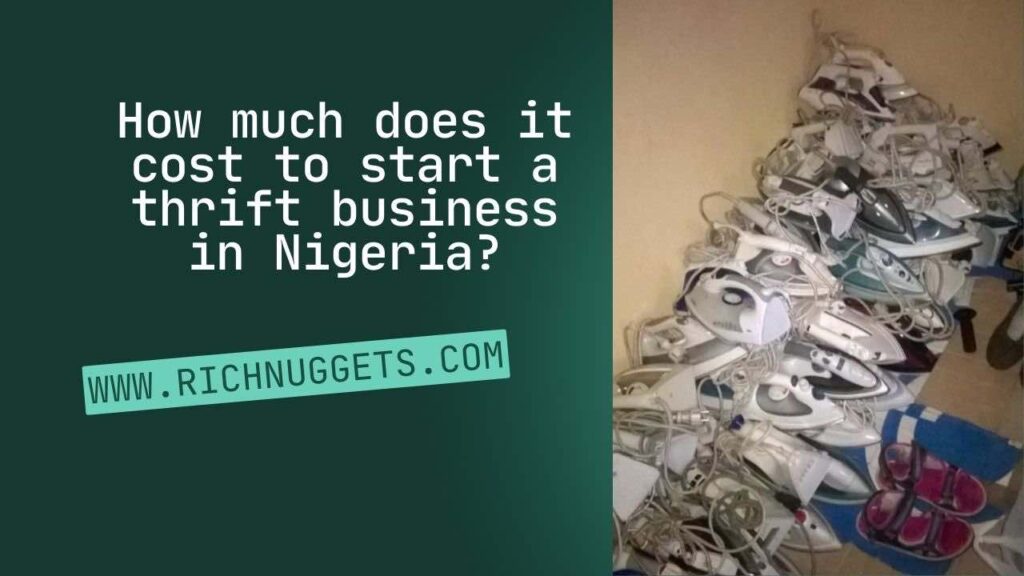
To start a thrift business in Nigeria, you can begin with a minimum capital of N3.5 million Naira. This amount will cover the expenses of acquiring an 18-seater bus, loading the bus with merchandise, and the necessary customs clearance for the container.
However, it is important to note that shipping a vehicle with loads inside is not allowed according to Nigerian customs law. The only exception is if the vehicle is transported within a container.
Transporting a bus in a 20ft container is expensive and wasteful in terms of space utilization. The clearing cost of a 20ft container is around N4.8 million Naira. Instead of incurring such expenses and potential losses, it is advisable to collaborate or partner with others who also want to ship their items to Nigeria. By sharing the costs among partners, you can save money and maximize profit.
Finding partners is relatively easy as the shipping company you choose will connect you with other individuals or businesses seeking similar partnerships.
With a minimum capital of N3.5 million Naira, you can start a small-scale thrift business in Nigeria.
However, if you aim to operate on a larger scale, you would need a minimum of N10 million Naira to secure and clear the shipping fee of a 20ft container. Within this container, you can accommodate a maximum of three vehicles and load it with a variety of sellable items.
It’s worth mentioning that costs may vary depending on the region you are sourcing your thrift items from. For example, sourcing thrift items from Asia tends to be cheaper compared to Europe and the United States. However, in terms of item quality, Europe ranks first, followed by the US, and then Asia.
But there is also an option of starting a thrift business as a retailer without getting involved with the shipping process. This means you will buy from those involved in shipping their thrift items, and sell as a retailer to customers. It will cost you a minimum of N700,000 to start a profitable thrift business as a retailer in Nigeria.
Is thrift business profitable?

Yes, the thrift business is highly profitable in Nigeria. Its profitability comes from the wide range of items it offers, including clothing, accessories, household goods, electronics, furniture, and more. This diverse selection attracts a larger customer base, contributing to its success.
The demand for second-hand items in Nigeria remains high due to their affordability and good quality. Many individuals prefer purchasing from thrift sellers over those selling new items.
During our research, we discovered that this preference, especially regarding electronics, is driven by the perception that most new electronic items sold by Nigerian traders are sourced from China and lack durability.
Conversely, electronic items sourced from thrift stores, particularly from Europe and the United States, boast good quality despite being second-hand. In fact, they often outlast new items from China.
The thrift business is so profitable that it has the potential to nearly double your initial investment if you start on a small scale with a minimum capital of N3.5 million Naira. If you decide to embark on a large-scale operation with a minimum investment of N10 million Naira, the potential returns can surpass triple your investment.
Challenges of Starting Thrift Store Business in Nigeria
Here are common challenges associated with starting a thrift store business in Nigeria:
- Negative Perception: Overcoming negative perceptions associated with second-hand goods can be a challenge. Some individuals harbor concerns about the quality and cleanliness of thrift store items, impacting customer willingness to shop at the store.
- Regulatory Compliance: Adhering to regulatory requirements and obtaining the necessary licenses can be challenging. Ensuring compliance with health and safety standards, consumer protection laws, and local business regulations is essential.
- Quality Control: Maintaining the quality of second-hand items is crucial for building customer trust. Thoroughly inspecting and cleaning items, addressing wear and tear, and ensuring that products are in good condition can be time-consuming.
- Sourcing Reliable Suppliers: Finding reliable sources for quality second-hand goods can be challenging. Establishing relationships with trustworthy suppliers or negotiating favorable deals with individuals selling used items requires effort and diligence.
- Inventory Management: Managing inventory efficiently, including categorizing items, pricing them appropriately, and rotating stock, is essential for a thrift store. Implementing effective inventory management systems can be challenging, especially for stores with a large and diverse inventory.
- Marketing and Branding: Building a positive brand image for a thrift store can be challenging, particularly if there is stigma associated with second-hand items. Effective marketing strategies that highlight the value, affordability, and uniqueness of thrift store products are crucial.
- Competition: Thrift stores face competition from other retail outlets, including traditional stores and online platforms. Standing out in a crowded market and offering a unique value proposition can be a challenge.
- Location and Visibility: Selecting an optimal location with high visibility and foot traffic is essential for the success of a thrift store. Finding the right location that is accessible to the target market may be challenging, and securing such locations can be competitive.
- Economic Factors: Economic conditions, including fluctuations in consumer spending and income levels, can impact the demand for second-hand goods. Thrift stores may experience variations in customer traffic based on economic factors.
- Payment Methods: Offering convenient and secure payment methods for customers, including cash and electronic payments, can be challenging. Thrift stores need to cater to diverse customer preferences in payment options.
- Cultural Perceptions: Addressing cultural perceptions about used items and second-hand shopping is important. Understanding and adapting to local cultural attitudes toward thrift stores is crucial for gaining acceptance.
- Online Presence: Establishing and maintaining an online presence, especially if aiming to reach a broader audience, may pose challenges. Managing e-commerce platforms, handling online transactions, and ensuring timely deliveries can be complex.
READ ALSO:
- How to Register a Business Name in Nigeria in 7 Easy Steps
- The Secret of Okrika Business: How to Start Okrika Business
- How to Start a Small Clothing Business from Home in Nigeria
- How to Start a Mini Importation Business in Nigeria (EASY GUIDE)
- How to Start a Small Business at Home
Final Thoughts on Starting a Thrift Store in Nigeria
That’s all on how to start a profitable thrift business in Nigeria.
Remember, success in the thrift business relies on efficient operations, effective inventory management, and continuous improvement.
Regularly evaluate your performance, make necessary adjustments to suit customers’ preferences, and take advantage of seasonal sales.
Do remember to turn on the Bell 🔔 Notification Icon to get updated on your device when new articles are published.
Discover more from StartBizEasy
Subscribe to get the latest posts to your email.
